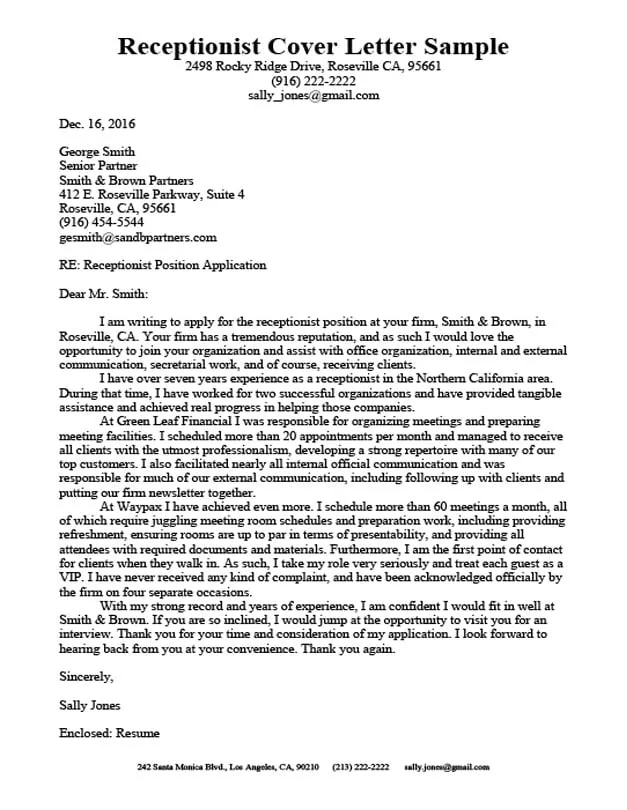Understanding the Importance of a Receptionist Cover Letter
A receptionist cover letter is your first opportunity to make a positive impression on a potential employer. It’s much more than just a formality; it’s a crucial marketing tool that showcases your personality, skills, and enthusiasm for the role. Unlike a resume, which provides a static overview of your experience, a cover letter allows you to tell a story, highlighting your relevant qualifications and explaining why you’re the ideal candidate for the position. A well-crafted cover letter can significantly increase your chances of getting an interview, demonstrating your professionalism, attention to detail, and genuine interest in the company.
Key Components of a Successful Cover Letter
A compelling receptionist cover letter includes several key components. Each section serves a specific purpose in presenting you as a well-suited candidate. From your contact information to the closing paragraph, every element should be carefully considered and tailored to the specific job you’re applying for. A well-structured cover letter demonstrates your understanding of professional communication, while also giving you the chance to show off a bit of your personality and writing skill. Let’s break down each element to help you create a cover letter that gets noticed.
Contact Information and Date
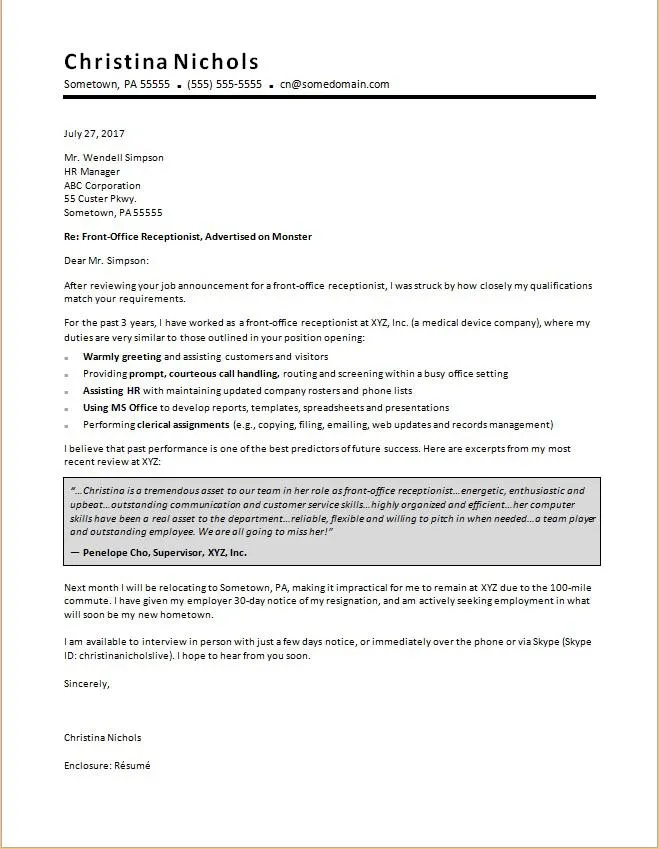
At the top of your cover letter, include your full name, address, phone number, and professional email address. Make sure your email address is appropriate and professional. Immediately below this, include the date you are sending the letter. This information is essential for the employer to easily contact you and also shows that you understand professional business correspondence protocol. Correctly formatting this section immediately lends credibility to your application.
Greeting and Salutation
Address the hiring manager by name if possible. Research the company to find out who the hiring manager is. If you can’t find a specific name, use a professional salutation such as ‘Dear Hiring Manager’ or ‘Dear [Company Name] Team.’ Avoid generic greetings like ‘To Whom It May Concern,’ as they can make your letter seem impersonal and suggest you haven’t taken the time to research the company. A personalized greeting demonstrates initiative and attention to detail, qualities highly valued in a receptionist.
The Opening Paragraph Grab Their Attention
Your opening paragraph is your chance to immediately capture the reader’s attention. Start with a strong statement that highlights your interest in the position and the company. Briefly mention your key qualifications and what makes you stand out. For example, ‘I am writing to express my keen interest in the Receptionist position at [Company Name], as advertised on [Platform]. With my five years of experience in a fast-paced office environment and my proven ability to provide exceptional customer service, I am confident I can make a significant contribution to your team.’ This shows the reader what makes you suitable for the job.
Highlighting Your Relevant Skills and Experience
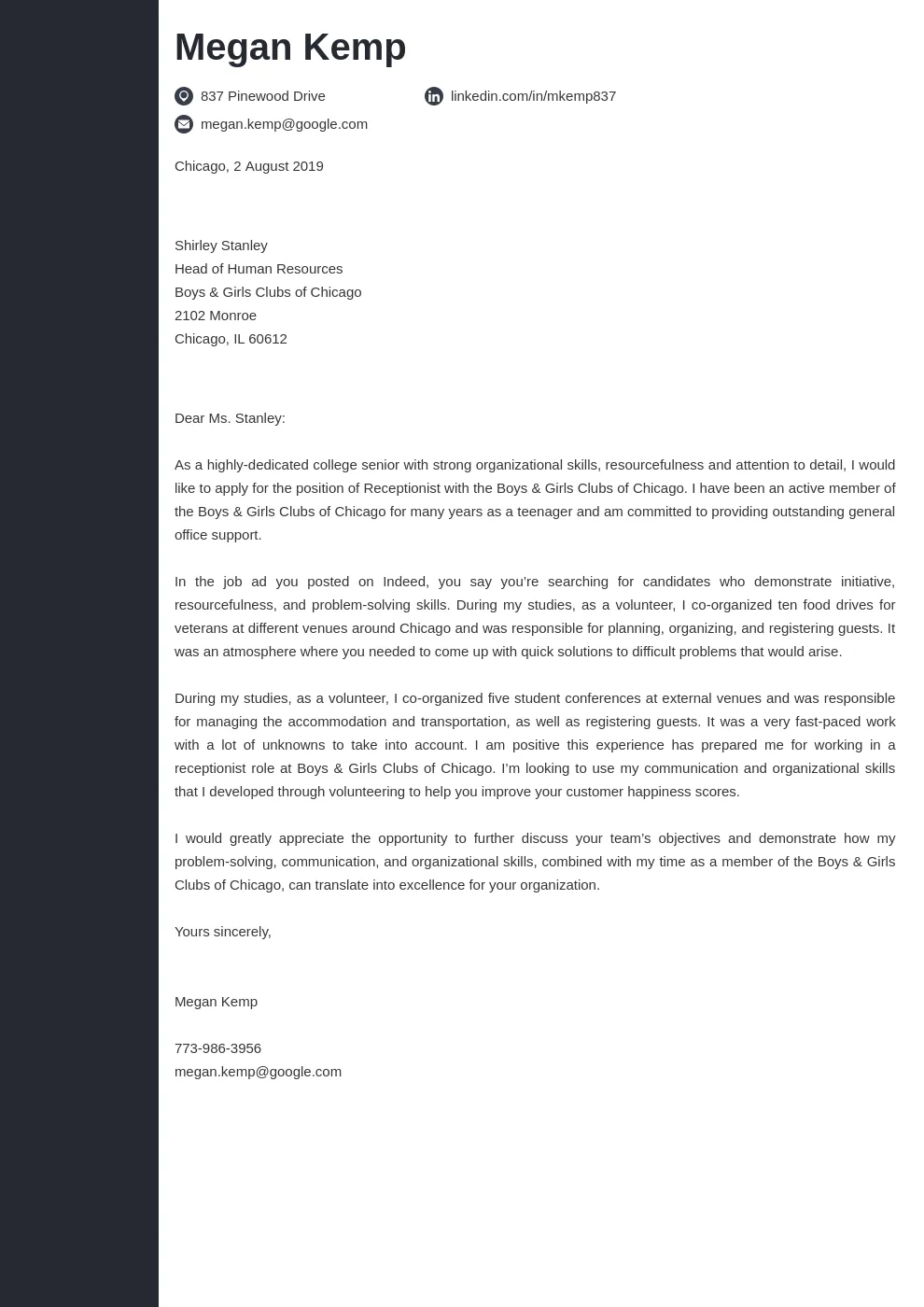
This section is the meat of your cover letter. Focus on the skills and experience most relevant to the receptionist role. Use specific examples to demonstrate how you have successfully performed these tasks in the past. Tailor this section to match the job description, highlighting the skills and experiences the employer is seeking. It’s important to showcase a range of skills, not just a list. Providing evidence that you have successfully used those skills in the past is the key to this part of your letter.
Communication and Interpersonal Skills
Receptionists must have excellent communication and interpersonal skills. Provide examples of how you’ve effectively communicated with clients, customers, and colleagues. This includes both verbal and written communication. Mention your ability to handle difficult situations with grace and professionalism. For instance, ‘In my previous role, I was responsible for handling a high volume of calls and emails daily. I consistently ensured all inquiries were addressed promptly and professionally. I also resolved customer complaints effectively, turning negative experiences into positive ones.’
Organizational and Administrative Abilities
Receptionist roles often require strong organizational and administrative skills. Highlight your ability to manage schedules, handle mail, and maintain office supplies. Use phrases such as, ‘I am proficient in managing calendars, scheduling appointments, and coordinating meetings. I have experience with various office software systems and am adept at maintaining organized records.’ Include any experience you have with specific software or tools used in an office environment.
Customer Service and Problem-Solving Prowess
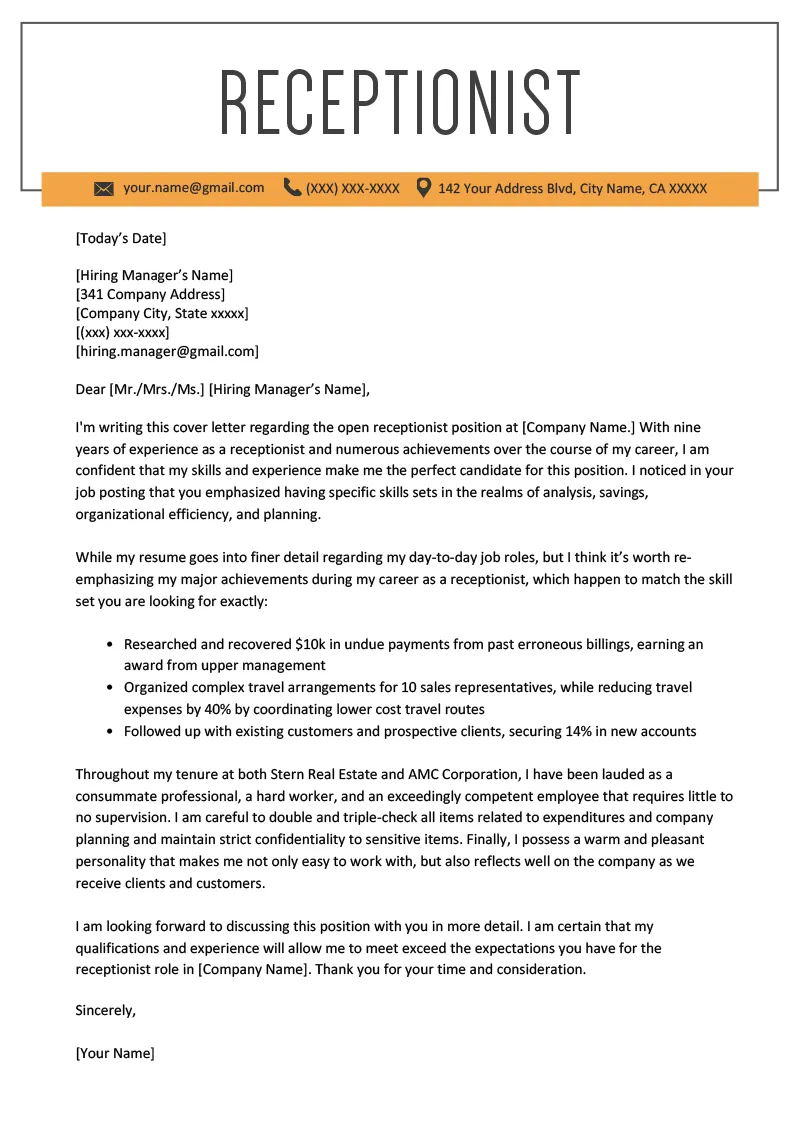
Receptionists are often the first point of contact for customers and clients, so excellent customer service skills are critical. Detail your ability to provide a welcoming and professional experience, solve problems, and go above and beyond to meet customer needs. Provide specific examples such as, ‘I consistently received positive feedback from clients for my ability to provide friendly, helpful, and efficient service. I have experience in resolving customer inquiries and complaints.’ Highlight any customer service awards or recognition you’ve received.
Tailoring Your Letter to the Job Description
Customize your cover letter for each job application. Carefully review the job description and identify the key skills and requirements. Then, tailor your letter to highlight the experiences and skills that match those requirements. Avoid sending generic cover letters. Tailoring your letter shows the employer that you’ve taken the time to understand their needs and are genuinely interested in the specific role and the company. It also highlights why you are the perfect candidate for this particular job, not just any receptionist position.
Researching the Company and Addressing Needs
Before you write your cover letter, research the company. Understand their mission, values, and the products or services they offer. This shows that you’re interested in the company itself, not just any job. You can then address the company’s specific needs in your cover letter and explain how you can contribute to their goals. For example, ‘I am impressed by [Company Name]’s commitment to [company value], and I believe my skills in [relevant skill] align perfectly with your focus on [company goal].’ Mentioning something specific about the company demonstrates your dedication.
Using Keywords from the Job Posting
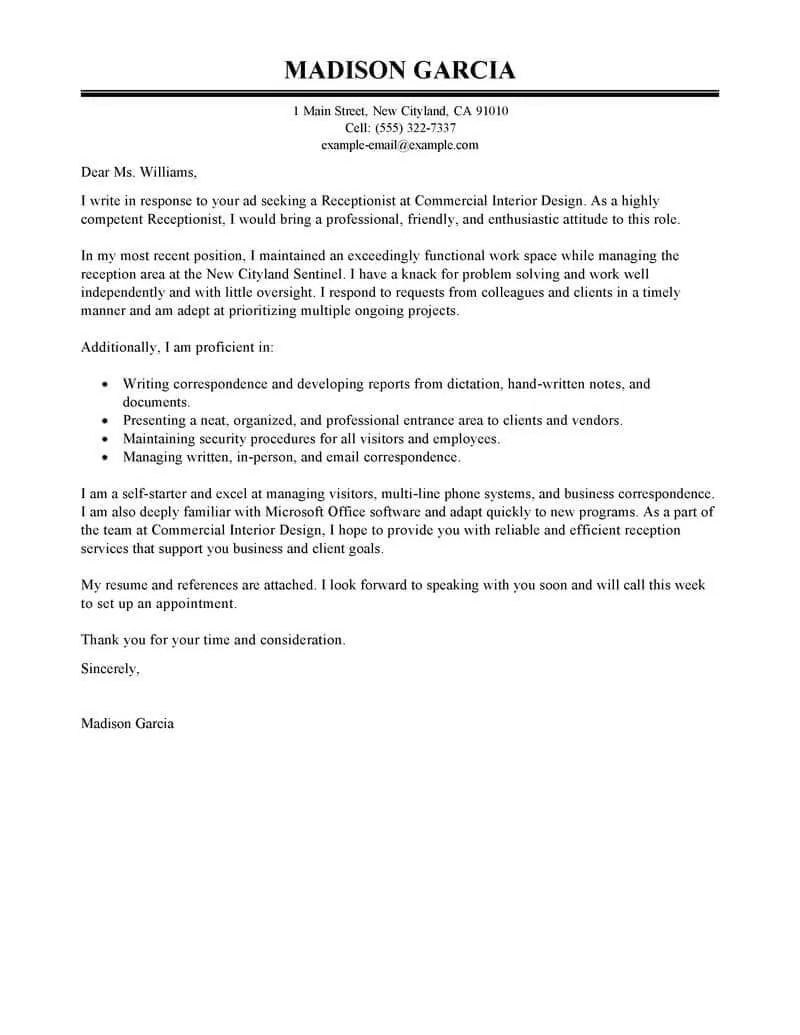
Carefully review the job description and identify the key keywords and phrases used. Incorporate these keywords into your cover letter naturally. This not only demonstrates that you possess the required skills and qualifications, but also helps your application get past applicant tracking systems (ATS) that scan for specific keywords. Make sure not to overstuff your letter with keywords, however. The text should still read naturally and be easy to understand.
Showcasing Your Achievements and Accomplishments
Rather than simply listing your responsibilities, focus on your achievements and accomplishments in previous roles. What did you accomplish? How did you make a positive impact? Use the STAR method (Situation, Task, Action, Result) to structure your examples. This helps you present your achievements clearly and effectively. For instance, ‘In my previous role, I streamlined the front desk procedures (Situation) to improve efficiency (Task). I implemented a new check-in system and trained other staff (Action), which resulted in a 20% reduction in wait times for visitors (Result).’
Quantifying Your Contributions
Whenever possible, quantify your contributions with numbers and data. This makes your accomplishments more compelling and demonstrates the impact you had in previous roles. For example, ‘Managed an average of 100 calls per day,’ or ‘Improved customer satisfaction scores by 15% through proactive problem-solving.’ Numbers are powerful tools to show your impact.
Providing Specific Examples
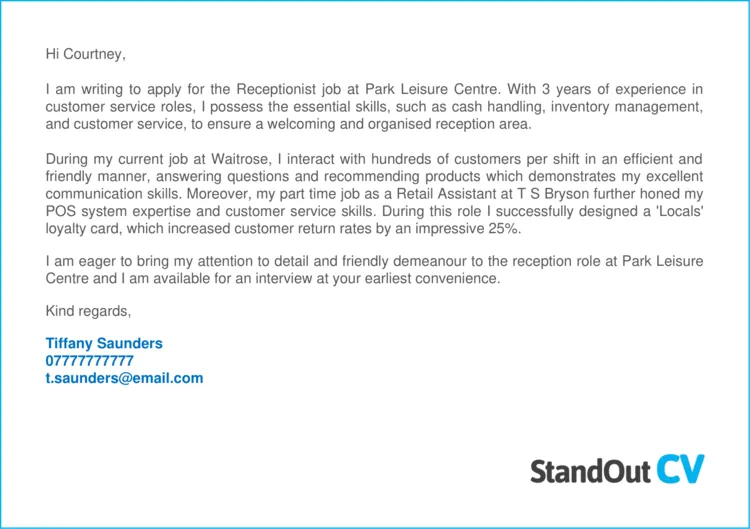
Provide specific examples that illustrate your skills and experience. Vague statements are less impactful than concrete examples. Instead of saying, ‘I have excellent communication skills,’ provide an example such as, ‘I successfully resolved a difficult customer complaint by actively listening to the customer’s concerns, apologizing for the inconvenience, and offering a solution that satisfied their needs. As a result, the customer left feeling valued and their issue was resolved to their satisfaction.’ Specific examples help the reader visualize you in action.
The Closing Paragraph Call to Action
In your closing paragraph, reiterate your interest in the position and the company. Express your enthusiasm for the opportunity and make a clear call to action. State your availability for an interview and provide your contact information once again. For example, ‘I am eager to learn more about this opportunity and discuss how my skills and experience can benefit [Company Name]. I am available for an interview at your earliest convenience and can be reached at [phone number] or [email address]. Thank you for your time and consideration.’ This final paragraph should be professional, positive, and action-oriented.
Expressing Enthusiasm and Availability
End your cover letter by expressing your enthusiasm for the position. This shows that you’re genuinely interested in the role and motivated to contribute to the company. Also, clearly state your availability for an interview. Make it easy for the hiring manager to contact you by providing your phone number and email address. This makes the next step, scheduling an interview, easy for the potential employer.
Proper Formatting and Proofreading
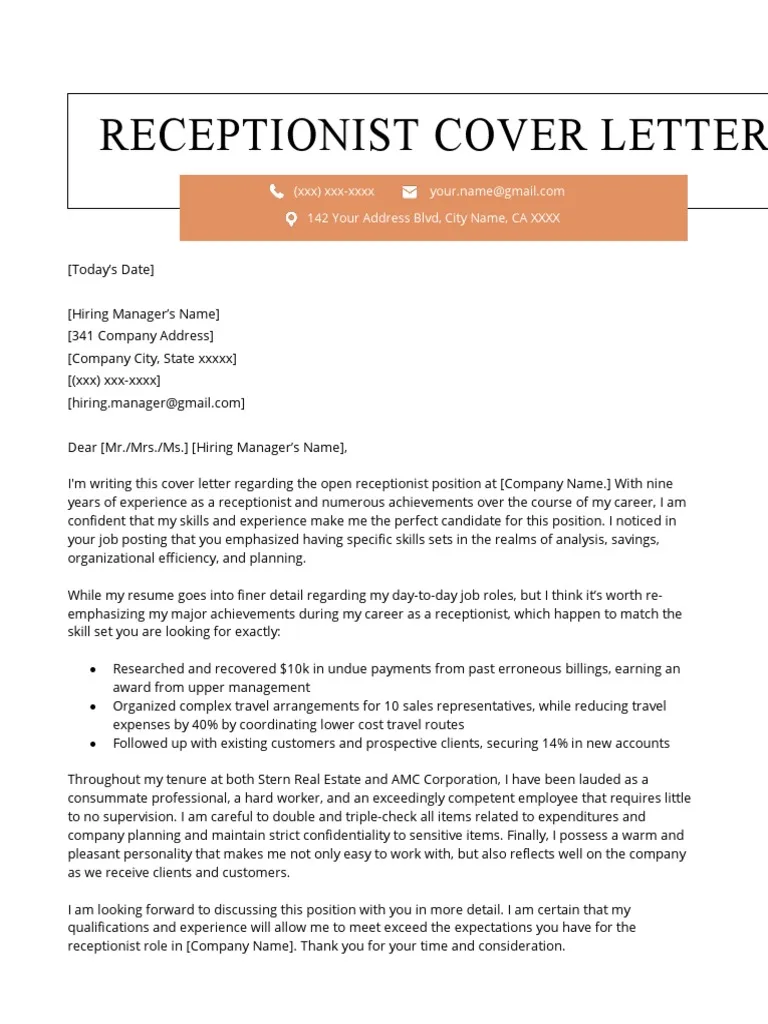
A well-formatted and error-free cover letter is essential for making a positive impression. Poor formatting and grammatical errors can undermine your qualifications and professionalism. Take the time to format your letter correctly and proofread it carefully. This demonstrates your attention to detail and your commitment to presenting yourself in the best possible light. A sloppy cover letter sends the message that you don’t care about the job enough to put in the effort.
Formatting Guidelines
Use a professional font such as Times New Roman, Arial, or Calibri, with a font size between 10 and 12 points. Use single spacing within paragraphs and double spacing between paragraphs. Use standard 1-inch margins on all sides of the page. Keep your cover letter concise and aim for one page. Use clear headings and subheadings to organize your content and make it easy to read. Ensure all sections are aligned appropriately and present a visually appealing and professional document.
Proofreading for Errors
Proofread your cover letter carefully for any errors in grammar, spelling, punctuation, and formatting. Read your letter aloud to catch any awkward phrasing or mistakes. It’s also a good idea to have a friend or family member proofread it for you. Fresh eyes can often spot errors that you might miss. Double-check the company name, the hiring manager’s name, and any other specific details to ensure accuracy. Errors, even minor ones, can create a negative impression and may cause the employer to disregard your application.
Examples of Effective Cover Letters
Reviewing examples of successful cover letters can provide inspiration and guidance when writing your own. Tailor these examples to fit your own skills, experience, and the specific job you’re applying for. Pay attention to how the letter is structured, the tone of voice, and the types of information included. Remember, you should never plagiarize; instead, use these examples as a starting point for creating your own original and compelling cover letter. The examples should show a variety of formats and styles to suit different professional environments.
Example 1 Cover Letter for a Traditional Office
This example showcases a cover letter for a receptionist role in a traditional office setting. It highlights strong organizational, communication, and administrative skills. The tone is professional and emphasizes experience in managing office tasks and interacting with clients. The example will include specific achievements, such as streamlining office procedures or improving client relations.
Example 2 Cover Letter for a Medical Practice
This example is tailored for a receptionist position in a medical practice. It emphasizes patient interaction, confidentiality, and knowledge of medical office procedures. The tone is empathetic and professional, with a focus on providing excellent patient care and managing patient schedules. The letter will highlight experience with medical software and patient management systems.
Example 3 Cover Letter for a Corporate Environment
This example focuses on a receptionist role in a corporate environment. It emphasizes professionalism, strong communication skills, and experience in managing a busy reception area. The tone is confident and professional, with a focus on representing the company and efficiently handling a wide range of tasks. The letter will include experience with meeting coordination and event planning.
Avoiding Common Mistakes in Receptionist Cover Letters
Avoid common mistakes that can undermine your cover letter and decrease your chances of getting an interview. By being aware of these pitfalls, you can ensure your cover letter showcases your skills and experience effectively. Addressing these mistakes and correcting them before submitting your application can drastically improve your chances of getting noticed by the hiring manager. Making these corrections are usually an easy way to increase your chances.
Generic and Vague Language
Avoid using generic and vague language that doesn’t provide specific details or examples. Instead of saying, ‘I am a good communicator,’ provide a specific example of how you have effectively communicated in a previous role. Generic statements do not showcase your qualifications or the results you have achieved. It is much more effective to use specific, action-oriented language to demonstrate your capabilities and accomplishments.
Typos and Grammatical Errors
Typos and grammatical errors can create a negative impression and suggest a lack of attention to detail. Always proofread your cover letter carefully, and consider having someone else review it as well. Typos and grammatical errors undermine your credibility and professionalism and make it seem as if you don’t care about the details. Taking the time to ensure your letter is free of errors shows that you are professional and thorough.
Failing to Tailor the Letter
Do not submit a generic cover letter to multiple job applications. Tailor each cover letter to the specific job requirements and the company’s values. Customizing your letter demonstrates that you have taken the time to understand the role and the company, which increases your chances of getting an interview. Tailoring shows the hiring manager you really want the job at their company, not just any job at any company.
Final Tips for a Winning Cover Letter
To create a winning cover letter, focus on the key elements discussed. Highlight your relevant skills and experience, tailor your letter to the specific job, and proofread carefully for any errors. Showcase your personality and enthusiasm for the role. Following these tips will improve your chances of landing an interview and securing the receptionist position. Remember, your cover letter is your first chance to make a great impression. It can set you apart from other candidates. Make sure it reflects your best self.
